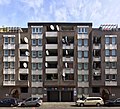Dietmar Grötzebach
Dietmar Grötzebach (born April 5, 1937 in Berlin ; † March 27, 1985 in Berlin) was a German architect and professor at the Technical University of Berlin .
Life
Dietmar Grötzebach was the son of the architect Paul Grötzebach and his wife Ingeborg, geb. Hilger. From 1939 to 1943 the family lived in Wolfenbüttel , where Grötzebach started school in 1943, and from 1943 in Hamburg , where he attended the primary school in Hamburg-Fühlsbüttel , from Easter 1947 the scientific high school in the Alstertal and took the high school diploma in spring 1955. After a six-month construction internship, he began studying architecture at the Technical University of Braunschweig , switched to the Technical University of Berlin after completing his intermediate diploma in 1957 and received his diploma in 1961 from Bernhard Hermkes at the Chair of Design, Construction and Industrial Construction. From 1962 to 1965 he worked as a freelancer for the architect Bodo Fleischer and was a research assistant at the chair of Prof. Bernhard Hermkes, who received his doctorate in 1965 on the subject of the change in criteria for evaluating the relationship between construction and form over the past 100 years .
From 1963 to 1985 Grötzebach ran an architecture office in West Berlin in partnership with Günter Plessow, from 1964 to 1972 with Günter Plessow (G + P) and Gerd Neumann (NGP), from 1974 to 1985 with Günter Plessow and Reinhold Ehlers (GPE). Other partners from 1972 to 1977 were Jürgen Sawade , Dieter Frowein and, from 1977, the sculptor Günter Ohlwein. Since 1968 a member of the board of the Association of German Architects (BDA) Berlin, Grötzebach was its chairman from 1978 to 1985.
From 1972 to 1985 Dietmar Grötzebach taught design and building construction as a professor in Faculty 8 at the Technical University of Berlin. In 1977 he wrote an expert opinion on the preparation of the IBA (International Building Exhibition Berlin) 1984/87 on behalf of the Berlin Senate and, as an architect of late modernism ( brutalism ), paved the way for critical reconstruction ( urban repair ). According to Thilo Hilpert , Grötzebach, who was friends with Josef Paul Kleihues and who developed concepts for securing historic perimeter block developments in West Berlin as early as 1973, was involved in the concept of building block 270 (1978) built by Kleihues in Berlin-Wedding, the first building block of the post-war period, involved and the question arises whether the return to block construction was "a revision in the formal language of modernity or an expansion of its syntax."
plant
NGP office:
- Grunewald service area, Kronprinzessinenwer, Berlin-Zehlendorf, 1965–1986
- Ev. Community Center Plötzensee , Heckendamm, Berlin-Charlottenburg-Nord, 1967–1970 (monument)
- Ev. Apostel Johannes Community Center, Berlin - Märkisches Viertel. 1970-1971
- Ev. School, Guerikenstrasse, Berlin-Charlottenburg, competition 1st prize, 1967–1973
- Tiergarten youth center, Rathenower Straße, 1st prize competition, 1969–1972
Office G + P:
- Urban redevelopment Bethanienviertel, Kreuzberg, 1st prize, redesign planning, 1974–1981
- Living at Kleistpark, Potsdamer Straße, Berlin-Schöneberg ( Pallasaeum ) together with Jürgen Sawade and Günter Frowein, 1974–1977 (monument)
GPE office:
- Block 100, Nauyn-, Mariannen- and Waldemannstraße, new building and renovation of old buildings, 1974–1981
- Redesign of Mariannenplatz, Berlin-Kreuzberg, 1975–1981
- Redesign of the Spandau market, 1st prize competition, 1977–1982
- Simonshof, Housing for the disabled and non-disabled, Berlin-Spandau, 1st Prize, 1978–1984
- House above the excavation, Reformationsplatz 4, Berlin-Spandau, 1979–1984
- Residential house Waldemarstrasse 94, Berlin-Kreuzberg, 1979–1981
- Mark Hotel Berlin, Meineckestrasse 24, Berlin-Charlottenburg
- IBA (International Building Exhibition Berlin): House Kochstrasse 7a – 14, Berlin-Kreuzberg
- IBA: Residential buildings Dessauer Strasse 11–12, Berlin-Kreuzberg
Fonts
- About construction and architectural form . Edited by Ute Heimrod and Dieter Eckert, afterword: Fritz Neumeyer. DOM Publishers, Berlin 2018, ISBN 978-3-86922-666-8
- City repair in the newspaper district . In: ARCH + , Berlin 1982, pp. 26-30
Web links
- strasse-der-moderne.de
- Literature by and about Dietmar Grötzebach in the bibliographic database WorldCat
- archplus.net
- f-iba.de
- f-iba.de
- f-iba.de
- sosbrutalism.org
- gfx.sueddeutsche.de
Individual evidence
- ↑ Dietmar Grötzebach: About construction and architectural form . Ed .: Ute Heimrod, Dieter Eckert. DOM publishers, Berlin 2018, ISBN 978-3-86922-666-8 , pp. 126-127 .
- ↑ Falk Jaeger: Avant-garde and adaptation, 100 years of the Bund Deutscher Architekten Berlin. Tagesspiegel, July 2, 2015, accessed on August 3, 2018 .
- ↑ Dietmar Grötzebach u. a .: Expert opinion: Preparation of an IBA Berlin. museum-digital: Berlin, accessed on August 3, 2018 .
- ↑ SOS for SO 36 . In: Der Spiegel . No. 13 , 1977 ( online ).
- ^ Thilo Hilpert: Century of Modernity. Architecture and urban planning. Essays and texts . Springer Vieweg, Wiesbaden 2015, ISBN 978-3-658-07042-7 , pp. 397 .
- ↑ Dietmar Grötzebach: About construction and architectural form . Ed .: Ute Heimrod, Dieter Eckert. DOM publishers, Berlin 2018, ISBN 978-3-86922-666-8 , pp. 154 ff .
- ↑ Away with the social palaces! Berlin politicians are calling for the 1970s high-rise buildings to be torn down. Bau Netz, March 9, 1998, accessed August 3, 2018 .
| personal data | |
|---|---|
| SURNAME | Grötzebach, Dietmar |
| BRIEF DESCRIPTION | German architect and university professor |
| DATE OF BIRTH | April 5, 1937 |
| PLACE OF BIRTH | Berlin |
| DATE OF DEATH | March 27, 1985 |
| Place of death | Berlin |







